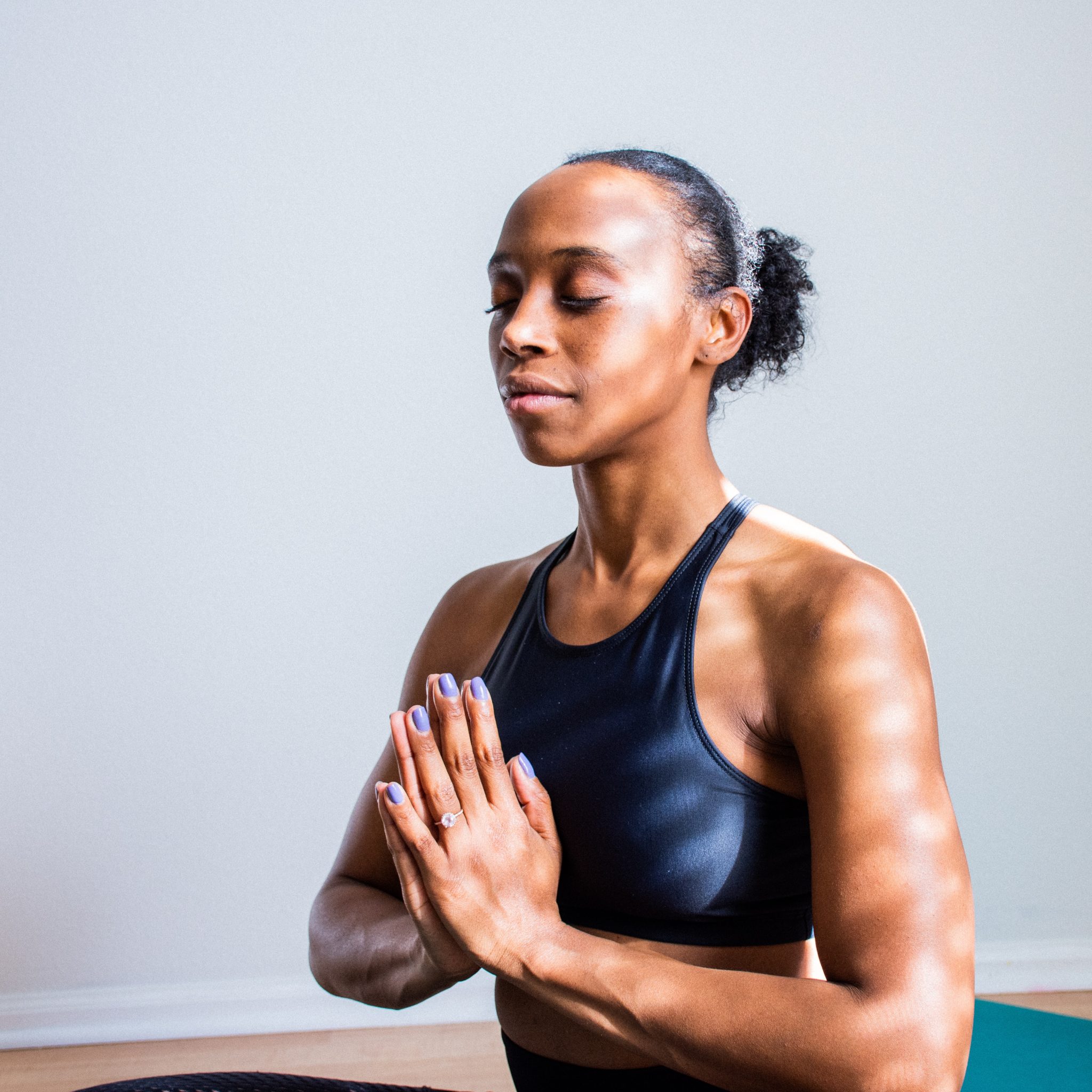There’s a reason you’re hearing the term ‘mindfulness’ more – especially when it comes to exercise. Balance your mind and body with these six expert tips.
You know that exercise moment when you’re in the zone: the fast-approaching 5k mark as Stormzy’s bassline is blaring through your earbuds, getting you closer to the finish line. While meditation is another form of ‘being in the zone’, this type of reflection and exercise aren’t activities that most people think of as going hand-in-hand. Yet, according to experts, tuning into our emotional state during the throes of a workout could double-up our training efforts.
“Research has revealed that our minds wander around 47% of the time, and that we’re less happy when we’re distracted, than when we’re focusing on what we’re doing – such as exercising,” says Dr Aria, a high performance psychologist and author of A Mindful Year.
“Mindful exercise involves letting go of unwanted thoughts and distractions, and instead, directing your attention to your physical sensations, breathing and body movements.”
You may also like
Self-care and mental health: 6 easy ways to be kinder to your body and mind
While many of us lace-up to escape the thoughts that revolve around our daily grind, director of healthcare partnerships at Headspace Sarah Romotsky, believes that it’s more about paying attention to what thoughts we’re already having.
“Exercise is as much about the mind as it is the body, with mindset being key for focus, motivation and performance. A great way to keep your mind healthy is by being physically active. Taking mindful moments for yourself whilst exercising is important to help get perspective on your thinking and connect mind with body.
“We constantly have thoughts running through our head – even when we exercise – such as ‘this is too challenging’ or ‘I’m too tired’. We should pay attention to these thoughts and emotions, but reframe our perspective on them. Let them come and go; they’re just thoughts, and once we recognise our thoughts as that, they hold less power over us. By incorporating mindfulness into exercising, we can help ground the mind, let go of negative thoughts, and manage our mind-to-muscle connection”
By incorporating mindfulness into exercising, we can let go of negative thoughts
We may know that the benefits of exercise on our mental wellbeing are plentiful (just 45 minutes three to five times a week can reduce anxiety and depression), but surprisingly, it can also have a direct impact on our PB.
“Being mindful while exercising can result in a more effective workout, a lower chance of injury, and a more positive relationship with your body,” Dr Aria explains. “Research has also revealed that focusing our attention during exercise affects the activity of our muscles. For example, focusing on the movement of our biceps during bicep curls results in greater muscular efficiency and maximal force production. The evidence indicates that this type of focus leads to more effective recruitment and coordination of the fibres within and between your muscles, allowing you to lift even more.” Just read our article on mind-muscle connection here.
Although Sarah isn’t usually an advocate of multi-tasking when it comes to mindfulness, exercise is a no-excuses exception for those who don’t have time for both. “Meditation is scientifically proven to help alleviate stress and increase happiness as it allows you to take a step back, pause the mind and feel better in the moment. Meditating while on the move is therefore a great way to incorporate mindfulness into your daily routine and help to improve your mental space – removing doubts and distraction.”

When we think about meditation, it’s the slower-paced workouts such as yoga or pilates that probably spring to mind, but the beauty of mindfulness is that it can be applied to any activity – even the high-intensity Stormzy-aided runs.
“The repetitive nature of running, continuously taking one step after another, can be harnessed as a form of meditation – enabling you to tune into your breath and the movement of your body,” Sarah says. “This can help you learn how to remain relaxed and confident, even while physically pushing yourself – and lead to more enjoyment and fulfilment from the run, rather than simply surviving it.”
“Mindful walking is also a fantastic example of this, as while moving, your attention is focused on the act of doing and the sensations that your body is experiencing. It can prevent the mind from having distracting and stressful thoughts, instead focusing your attention on the present moment. This helps you to step away, refresh the mind, and tune into the rhythm of the body.”

6 WAYS TO HAVE A MINDFUL WORKOUT
Take in your surroundings
Mindful exercise doesn’t mean we have to have our eyes closed. “You can use meditative techniques with your eyes wide open. Focus your attention on the environment around you, whether you are indoors or outside – take in all the sights, sounds and smells. In particular, those sensations you would not normally notice – make a mental note of them, and move on,” Sarah suggests.
Listen to your body
Instead of relying on a pumping playlist to help you through a workout, Dr Aria suggests listening to how you feel instead. “Notice if you’re tired, focus on keeping correct form and check on your breathing, thirst, perspiration and body. Research analysis has found that daydreaming while running increases your chances of fatiguing.”
Set your intention
Before you begin your workout, take a moment to set your intention. “Take a couple of deep breaths in through the nose, and out through the mouth,” Sarah says. “Concentrate on your breath and focus. Set a goal of what you want to achieve from this workout session, whether it’s walking around the block, running a 5k, or aiming to do 50 squats in your living room.”
You may also like
6 simple mindfulness exercises to help you cope with work stress
Notice self-defeating thoughts
Keep your internal critic in check. “The key to mental wellbeing and higher performance is to realise that just because you have a thought, doesn’t mean that it’s necessarily true,” Dr Aria warns. “The first step is to notice any self-defeating thoughts. The next is to respond to them with an empowering thought, which can be motivational (ie “I can do this”) or instructional (ie “eyes on the ball”)”.
Acknowledge your achievement
Remember to give yourself a well-earned pat on the back. “Reflect on the workout and remind yourself of what you have achieved. As you continue with your day, maintain that feeling of accomplishment,” Sarah says. “Remember what got you motivated, how you felt, and how you were able to let your thoughts come and go.”
Focus on the muscles you’re stretching
Instead of checking your phone, keep the focus going. “Direct your attention to the area that you’re stretching. Take five slow breaths and envision breathing oxygen into those same muscles. Notice how your focus and breath can soften any feelings of tension or tightness,” Dr Aria says.
Follow @StrongWomenUK on Instagram for the latest workouts, delicious recipes and motivation from your favourite fitness experts.
IMAGE: Unsplash, Getty
Source: Read Full Article
